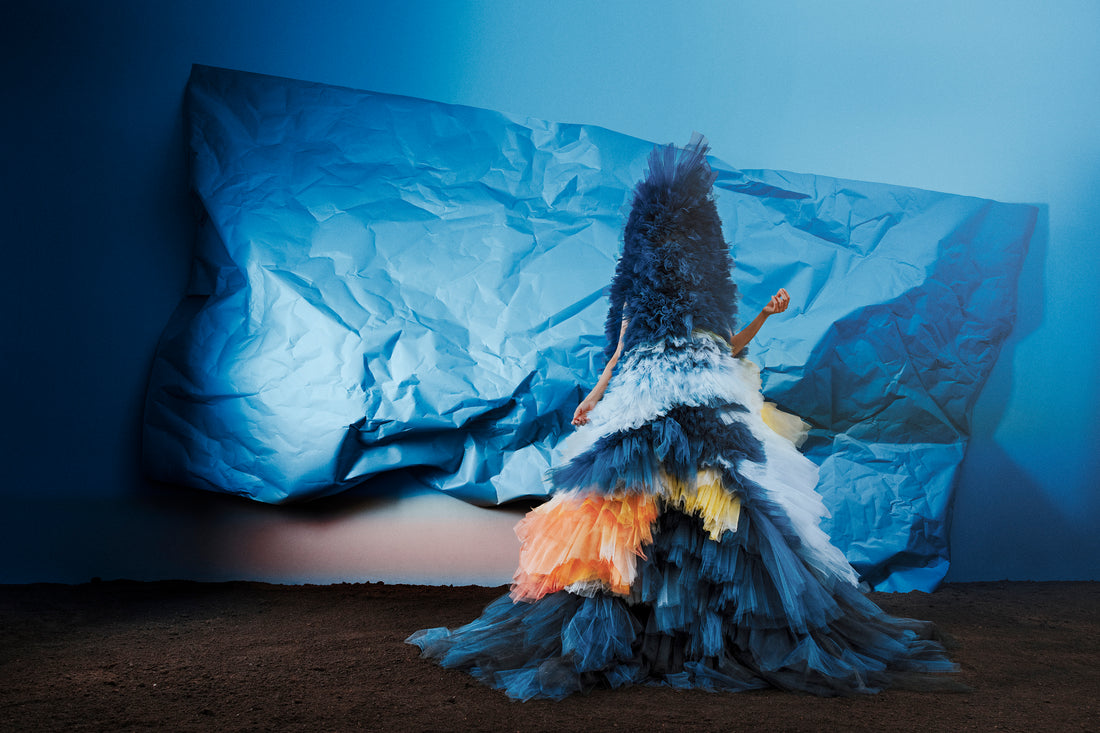A collection of 21 reinterpreted folk costumes that reflect various regions of Denmark is exhibited at the Designmuseum Danmark. Designer Nicholas Nybro is the creative mind behind these artworks, which each tell their own story of identity, diversity, environment, spirit, and sense of belonging.
“I want to take you on a journey around the country and tell you about the people I have met and the processes I have been through,” says fashion designer Nicholas Nybro in a video that plays on in one of the exhibition halls at Designmuseum Danmark. ‘Proud’ is Nicholas Nybro’s first solo exhibition, and it is a fascinating tour de force that the designer invites you to partake in.
With 21 modern interpretations of folk costumes rooted in different cities and regions across Denmark, stepping into Nybro’s creative universe is a thrilling, fun, and thought-provoking experience. Nicholas Nybro has created storytelling costumes whose forms, colours, and materials reflect the identity and uniqueness of the various places that he has travelled, from Hirtshals to Amager.
Glitter, Legos, and festivals
Over the past few years, Nicholas Nybro has travelled around the country to find inspiration for his designs. He has explored various historical folk costumes and delved into the contemporary spirit of the Danish people and the locals’ connection to their homeland. Subsequently, he has reinterpreted the concept of folk costume and now present his vision of what folk costumes might look like in 2023.

STOLT, design af Nicholas Nybro, Billund. Foto: Thomas Cato
Billund’s colourful costume is inspired by Lego, the Herning costume is based on businesses and company logos, with references to Aage Damgaard’s Angli shirt, and the costume for Roskilde is inspired by the large annual music festival. Nybro has chosen seven themes: the city, life, breaks, community, industry, celebration, and nature, and through them he plays with aesthetics, gender, stereotypes, function, and craftsmanship in the costumes for the different cities and regions. Places like Strynø, Tisvilde, Christiana, Sønderborg, Randers, Aalborg, Vollsmose, and many more are also represented.

STOLT, installationsfoto. Randers. Foto Designmuseum Danmark
The costume for the suburb Valby was designed with both humour and thoughtfulness. It is a tracksuit in green and burgundy glitter fabric with Valby’s postal code displayed across the chest and a cap to top it off. Nybro has found inspiration for the colours in the historical folk costumes of Valby, which the so-called ‘hønsekoner’ (chicken wives) wore in the 1700s and 1800s, branding them as they sold their poultry in Copenhagen. In addition to the history of folk costumes, Nybro also brings his own story into play. He grew up in Valby on Vigerslev Allé. “Now I want to start owning my heritage,” Nybro explains in the exhibition, hence the word ‘PROUD’ on the Valby cap.
Inner and outer projection
Nicholas Nybro is a sublime storyteller, and it works well when he integrates his own stories and the history of the places into the exhibition. Wearing a leopard-print jacket and a black cap, he appears on a screen next to each of the 21 costumes, where he briefly and engagingly talks about his thoughts behind the designs. This creates space for the viewer to reflect on their own perception and experience of Denmark. The exhibition is well-curated and arranged in a way that the films do not interfere with each other.
The exhibition is lively, loud, and fast-paced, and at times, it can be challenging to take it all in, but you rarely feel that you are missing out on something. If you want to deep dive into the small details, there are benches set up in the exhibition, where visitors can sit down and delve into the process and history behind the costumes in the book published about the exhibition.
STOLT, installationsfoto. Foto: Designmuseum Danmark
That Nybro wants to tell a story and create a dialogue is also evident in the costume from Esbjerg. It is an abstract costume that consists of a photo collage and light projection. The costume comes to life in the exhibition only when you step into the projected photos of Esbjerg. Nybro sensed that, in Esbjerg, art did not play such a prominent role, and thus he chose to create a kind of art installation for the industrious business city of Esbjerg.
Loud dresses
Nicholas Nybro became widely known for his design of a red dress worn by Ghita Nørby at one of the Queen’s galas in 2016 – a dress that garnered attention and much media coverage afterward. Nybro is not a man who is afraid to express his opinions. There might be too much concrete, too few educational institutions, or too few men in speedos at the swimming pool – the latter as a jab against homophobia. At the same time, he is generous with his hugs and shares freely of his love for the uniqueness of the places.
STOLT, design af Nicholas Nybro, Fanø. Foto: Thomas Cato
Fanø has received a large inflatable declaration of love. That is how Nybro describes it himself, as he was blown away on the island both literally by the wind and by the island’s idyllic charm. The costume is loud and thunderous and draws an audience every 10 minutes when inflated. In dark green, blue, and burgundy shades, the costume transforms into a large and wild balloon that slowly deflates. It's a fun way to incorporate local individuality into a costume, and there is plenty of fun ideas and thoughtfulness in the 21 modern folk costumes.
The exhibition ‘Proud – a modern narrative of folk costumes’ will be on display at Designmuseum Danmark until 3 March 2024.
By Tine Bonde Christensen / Translation: Ann Lykke Jensen.
Translation: Ann Lykke Jensen
Published in magasinet arkitektur/design no 4, 2023.
Top Image: STOLT, design af Nicholas Nybro, Højer. Photo: Thomas Cato

